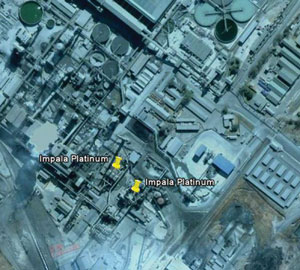

As part of Impala Platinum’s drive to standardise operational control and plant visualisation across its mines, Rockwell Automation has extended the installation of its PlantPAx system to the new No 17 Shaft refrigeration plant. Using standardised control modules and engineering methods developed specifically for the mining industry, this turnkey project with PlantPAx at its core will help to reduce refrigeration costs and improve efficiency by reducing downtime and lowering energy requirements.
No 17 Shaft is one of Impala Platinum’s deepest at over 1750 metres, and the refrigeration plant is designed to provide cold air for mining operations underground. The shaft is currently in the development phase and is scheduled to commence production in 2020.
Rockwell Automation was sub-contracted by BBE Projects and managed by the mine’s main EPCM contractor, WorleyParsons. Rockwell Automation’s role was to design, procure, manufacture, install and commission a turnkey system that controls and reports on the shaft’s York YD centrifugal chiller – the first of its kind to be installed in Africa. “This is also the first York refrigeration machine to utilise Rockwell Automation control hardware as specified by Impala Platinum, making it easier to interface the plant’s proprietary controls with the PlantPAx system,” says Rockwell Automation lead engineer Christo Lötter.
The PlantPAx system is configured to gather data from the refrigeration plant’s water flow, air velocity, temperature, humidity and vibration meters, as well as other third-party instrumentation, and relay the data to the programmable automation controller (PAC). Desktop PCs running the PlantPAx HMI will provide a complete bird’s-eye view of the plant. “This system is further connected by Ethernet over fibre to Impala Platinum’s greater network and central control room, which will enable better monitoring for faster and more informed decision making,” explains Lötter.
The control system also includes three DeviceNet and three ControlNet networks which interface with the plant’s variable speed drives, the York proprietary control system and the remote I/O.
This refrigeration plant is the first of its kind to make use of variable speed drives to power the bulk air cooler fans. “We can vary the speed of these fans – based on the load reported by the PlantPAx system – which will allow Impala Platinum to optimise the plant’s energy consumption based on the underground cooling requirement,” says Lötter.
On the electrical side, Rockwell Automation supplied two medium-voltage transformers, a medium-voltage switchboard, two low-voltage motor control centres, earthing, lightning and fire protection, as well as all plant lighting, small power distribution and UPS systems.
“We also supplied and installed the process instruments, making this a full EC&I project for Rockwell Automation. Our project department has the capability to do full reticulation and design work, with entire projects managed from design to commissioning. In total, we had nine contractors to manage, including manufacturers, earthing specialists, switchgear specialists and electrical installation teams,” says Lötter.
Having a single source supplier to manage subcontractors, as well as having a standardised control architecture across the board means Impala Platinum significantly reduces risks associated with multiple vendors and software standards. It also means a tighter level of integration for more comprehensive visualisation and reporting. The standardisation further benefits the mine as technicians are immediately familiar with the system, which speeds up repairs and reduces the variety of spare parts that must be kept on hand.
This complete electrical, instrumentation and control system implementation forms part of the shaft’s first phase of development. Phases two and three will include the addition of two motor control centres, two medium-voltage transformers, low-voltage motors and another three York refrigeration machines. “One of the main benefits of the PlantPAx system’s seamless integration is that adding more instrumentation and field devices is relatively simple,” says Lötter.
The majority of the electrical equipment installations were completed during phase one in preparation for phase two and three.
For more information contact Christo Lötter, Rockwell Automation, +27 (0)11 998 1000, [email protected], www.rockwellautomation.co.za
| Tel: | +27 11 998 1000 |
| Email: | [email protected] |
| www: | www.rockwellautomation.co.za |
| Articles: | More information and articles about Rockwell Automation |

© Technews Publishing (Pty) Ltd | All Rights Reserved